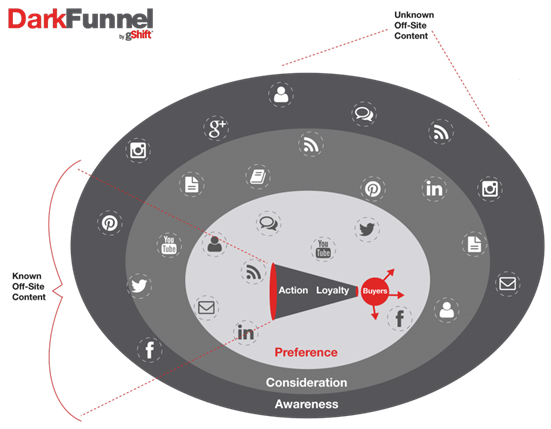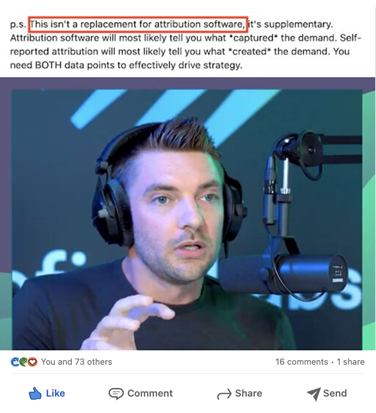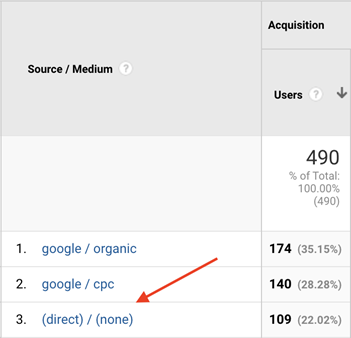Are you worried that the dark funnel will make your marketing attribution irrelevant?
If you work in B2B marketing, you've probably heard about the "dark funnel." It refers to all of the places (or channels) where customers hang out and engage in conversations or learn about your brand.
Those places include social media and messaging platforms, Slack communities, Zoom calls, real-life meetups, YouTube videos, and so on (even TikTok).
So, how do you implement marketing attribution if customers are making decisions while they're in that dark funnel?
Luckily, there is an alternative marketing attribution and measurement model that takes your dark funnel into account and sheds light on both the measurable and unmeasurable parts of it.
In Part 1 of this article series, you'll learn about the dark funnel, including why it should not dissuade you from using attribution to measure your marketing activities.
In Part 2, we'll cover the practical steps you can make to take the dark funnel into consideration as part of your overall measurement strategy.
The Origins of the Dark Funnel

One of the earliest online mentions of the dark funnel is in this article, written by Krista LaRiviere in early 2016.
She coined the term after extensive research into how the customer journey had changed. The traditional sales funnel still existed, as it does today, but—she discovered— prospects would enter it and build their awareness and preferences before the marketer even knew they were there.
It was an accumulation of a variety of off-site customer touchpoints that included social platforms, third-party communities, and other platforms and gatherings not controlled by brands.
The impact of the dark funnel on B2B marketing is clear: In the past, marketers have used the sales funnel to monitor, measure, and optimize the long journeys of their customers; but the dark funnel poses a problem for that methodology because a large part of the customer journey is occurring without marketers' being able to measure it.
Why Attribution Is So Important
B2B marketing influencers, such as Chris Walker (pictured below), who highlight the importance of the dark funnel do so to illustrate the fact that marketing attribution alone is insufficient. They claim that many businesses do not measure various important marketing activities, such as word-of-mouth and closed-community conversations.

We can all agree that attribution has its problems, but completely giving up on it is not a good idea.
Marketers who use attribution have something in common with investors who invest in the stock market: Even though investors don't have all the information when they invest in stocks, they can still make a fortune. Investors understand that decision-making in an uncertain environment is part of the game.
The same is true for attribution. It's one of the most powerful tools for marketers who want to drive revenue impact and make revenue-driven marketing decisions.
What's in the Dark Funnel?
An potentially endless number of information sources exist that constitute the dark funnel. These are among the most well-known:
- Word-of-mouth: There's no way to track one of your audience members recommending your product to a friend via email or over the phone.
- Dark social: This is a general term that refers to everything that is not trackable on social media, including DMs, comments, group threads, etc.
- Paid social views: You track site visitors coming from paid social, but what about people who simply view your video ad?
- Reviews: Product review sites such as G2 are often a common part of the buying journey in B2B.
- Third-party communities: Slack, Discord, Reddit... conversations around your brand may be happening in such places without any way to track them.
- Podcasts: Until someone invents an audio pixel, podcasts remain in the realm of the dark funnel.
Dividing the Dark Funnel Into Measurable and Unmeasurable Sources
Although the dark funnel is difficult to quantify, it can be divided into two types of sources: measurable and unmeasurable.
Unmeasurable sources include everything that happens behind the scenes—for example, word-of-mouth. There is no way to track such things, and we have to accept that.
Measurable sources, however, are something we can work with. They include sources that are not being tracked—or not tracked correctly—but which could be fully or partly measured, with some effort. All it takes is for you to be a little creative about improving measurement on activities that you're not tracking, or not tracking well.
Measuring the Dark Funnel
Measuring the dark funnel is a bit like measuring dark matter. Scientists measure dark matter indirectly, by exploring its effect on regular matter: "We can detect the dark matter through gravitational lensing, which detects shifts in light produced by distant celestial objects."
In the same way, you can use certain metrics from your regular funnel to gain insights into your dark funnel.

Such metrics can include...
- Direct traffic. Not all visitors who arrive directly on a website are part of the dark funnel, but many of them are. There's an expected correlation between direct traffic and your dark funnel. If one rises, it may indicate a rise in the other. To look at direct traffic as dark funnel traffic, make sure to properly map all other channels so they do not fall into the dark funnel bucket for no good reason.
- Paid and organic brand searches. When people search for your brand name on Google, they click either on your paid ad or on an organic search result. Brand searches are similar to direct traffic: Google serves as a pit stop in between. Say you run an ad on a popular podcast and the host of the podcast mentions your brand. Some audience members listening to the podcast will likely go to a search engine, search for your brand, and then click on the paid or organic result. You should expect to see a correlating spike between the date of the podcast publication and your brand searches.
Important note: correlative metrics by themselves are not enough. You must ensure that you have set accurate tracking and mapping in place first. Otherwise, you risk deploying too many resources based on those metrics and arriving at the wrong conclusion.
Next Steps: Developing a Holistic Measurement Strategy
Having gained a deeper understanding of the dark funnel, we can now find ways to handle both its measurable and unmeasurable components.
Stay tuned for the second part of this article, in which we'll cover which practical steps you can take to measure the dark funnel and how it can be incorporated into your analytics strategy.
More Resources on the Dark Funnel
Your Buyers Start Their Journey in the Dark Funnel, and You Need to Be There When It Happens
Four Ways AI Can Win You More Customers
For Outstanding Buyer Experiences, Think Big but Start Small




